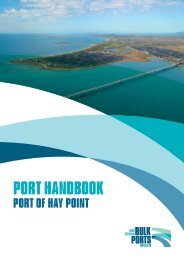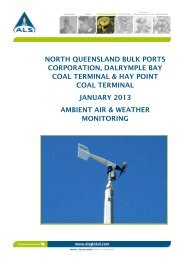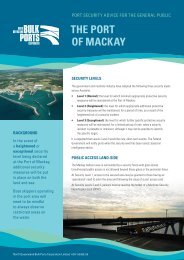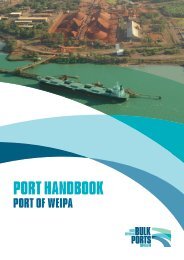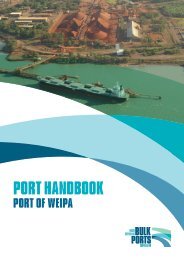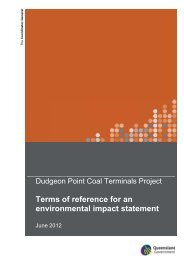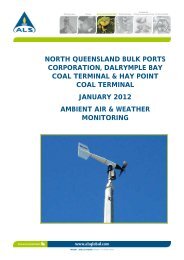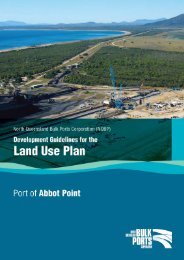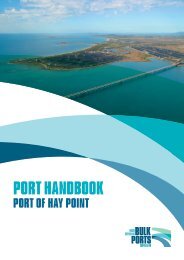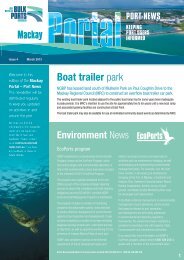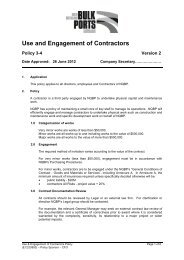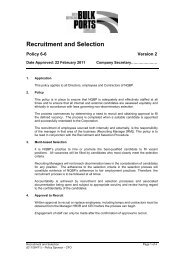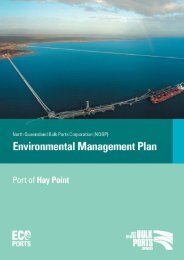Dudgeon Point Coal Terminals Project â Q and As - North ...
Dudgeon Point Coal Terminals Project â Q and As - North ...
Dudgeon Point Coal Terminals Project â Q and As - North ...
You also want an ePaper? Increase the reach of your titles
YUMPU automatically turns print PDFs into web optimized ePapers that Google loves.
Roads <strong>and</strong> Traffic<br />
How is the increased traffic on Hay <strong>Point</strong> Road going to be managed during construction?<br />
The construction of the <strong>Dudgeon</strong> <strong>Point</strong> <strong>Coal</strong> <strong>Terminals</strong>, offshore wharves, the railway spur <strong>and</strong><br />
supporting infrastructure will be carried out in stages, with construction of the stages likely to occur<br />
intermittently over a 10 to 20-year period. This will generate an increase in road traffic on Hay <strong>Point</strong><br />
Road.<br />
To reduce the volume of construction worker vehicles on the local roads, workers will be largely<br />
transported by bus to <strong>and</strong> from the site from pick-up points in Mackay <strong>and</strong> Sarina.<br />
The BMA HPX3 expansion will be completed before commencement of the <strong>Dudgeon</strong> <strong>Point</strong> <strong>Coal</strong><br />
<strong>Terminals</strong> which will reduce the number of construction vehicles as a baseline. The development has<br />
been designed as a cut <strong>and</strong> fill operation to minimise the volume of material imported or exported by<br />
earth moving trucks from the site. Rock revetment walls will be required for some marine works that will<br />
require transport of rocks early in the development stage only. The EIS will document any of these<br />
requirements.<br />
Further, a large number of large construction components are expected to be shipped to the Port of<br />
Mackay, offloaded <strong>and</strong> barged to the <strong>Dudgeon</strong> <strong>Point</strong> site or Half Tide Tug Harbour to reduce the<br />
transport of oversize loads to the port.<br />
The impact of an increase in traffic will be considered as part of the EIS process.<br />
How is the increased traffic on Hay <strong>Point</strong> Road going to be managed once the proposed <strong>Dudgeon</strong><br />
<strong>Point</strong> <strong>Coal</strong> <strong>Terminals</strong> are operational?<br />
When construction has been completed <strong>and</strong> coal exports started, a workforce of operational <strong>and</strong><br />
maintenance staff (around 640 after all three stages per terminal have been completed) will be employed<br />
or contracted at the terminals. It is anticipated that these workers will live in the local region. They will<br />
enter the <strong>Dudgeon</strong> <strong>Point</strong> site through the new port road that will be next to the rail line into the site.<br />
Will Bally Keel Road be the main access route for <strong>Dudgeon</strong> <strong>Point</strong>?<br />
The main access road to <strong>Dudgeon</strong> <strong>Point</strong> will be through a new road built by NQBP near the Bensons<br />
Road/Hay <strong>Point</strong> Road intersection. NQBP proposes to build a haul road into the <strong>Dudgeon</strong> <strong>Point</strong> site as<br />
part of the first site works, which will greatly minimise the use of Bally Keel Road, except for the very<br />
initial earthworks.<br />
Bally Keel Road will only be available to emergency services as an alternative entry site in the event of<br />
an emergency situation.<br />
Why are the rail lines into <strong>Dudgeon</strong> <strong>Point</strong> going over Hay <strong>Point</strong> Road?<br />
A flat entry for a full train length (two kilometres) into the rail unloading station is required because the<br />
trains need to move slowly <strong>and</strong> controlled through the unloading station. Due to the higher elevations of<br />
the site in the unloading area, this places the rail line at an elevation well above Hay <strong>Point</strong> Road.<br />
The rail lines will be on a rail overpass over Hay <strong>Point</strong> Road to prevent disruptions to Hay <strong>Point</strong> Road.<br />
Eight rail lines are proposed over the road – six into <strong>Dudgeon</strong> <strong>Point</strong> <strong>and</strong> two departure lines. A clearance<br />
of eight metres will be required to allow for the transportation of large equipment to the existing<br />
terminals.<br />
Page | 8



